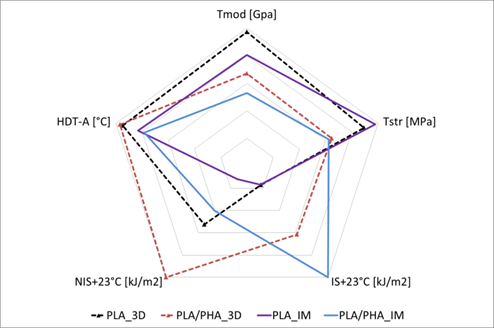
Bio-based materials for additive manufactur-ing (am) with excellent impact strength
Due to increasing use of bio-based materials, blends of pla and pha are investigated in the field of 3d-flm printing.
PLA (polylactic acid) biopolymer is one of the most common 3D-FLM printed materials. Due to its lower printing temperature PLA is easier to print compared to other polymers and therefore better suited for parts with fine details and ideal for 3D prints where aesthetics are important. PLA poses excellent tensile properties while impact properties are very low. Impact strength and notched impact strength values are 20 kJ/m2 and 1.5 kJ/m2 respectively. In order to improve the impact strength of PLA several approaches could be employed, e.g. addition of plasticizers or traditional impact modifiers, mineral fillers or other bio-based compostable polymers. In the project “Biorest, WP3” we explored the potential of different bio-based formulations based on PLA as matrix polymer for additive manufacturing (AM). In order to improve the impact performance of 3D printed PLA-based parts, the adhesion between the PLA-based 3D printed layers as well as the filament flexibility amorphous PHA (aPHA) copolymers (poly-hydroxyalkanoate) were added. The obtained so-called PLA/PHA blends are mixtures of these two polymer types, where PLA is the matrix. These PLA/PHA blend could be prepared via conventional polymer melt blending process and further transformed into a filament (filament extrusion line) for 3D-FLM printing process.
In this project, we used various amorphous PHA copolymers as an impact modifier for PLA. This additionally does not influence the bio-based carbon content and compostability of PLA as the same is true for aPHA. NatureWorks produced the used PLA-types that according to the data sheets mainly were used for injection molding.
The mechanical performance of double bone specimens prepared by either injection molding or 3D printing process, were determined and compared. After the optimization of the 3D-FLM printing process parameters (e.g. infill density, bed temperature, so.) 3D-FLM printed parts from PLA/PHA showed excellent notched impact strength values, up to 3 times higher than the notched impact strength values of injection moulded parts.
Why it is sustainable to use PLA/PHA blends?
PLA is a bio-based material made from renewable resources and is compostable according to the US and EU standards. It is characterized by excellent clarity, Tg of 60-65°C, and high modulus of about 3 GPa.
Amorphous PHA (a-PHA) is also a bio-based material made from renewable resources and is compostable according US ASTM D-6400 and EU EN-13432 standards. It is soil degradable (ASTM D-5988), marine degradable (D-7081), and degradable under both mesophilic (medium temperature) and thermophilic (higher temperatures) as well as anaerobic conditions (D-5511).
Summarized it can be stated that PLA/PHA blends can be processed by standard 3D-FLM printing machines under proper selection of 3D printing parameters very well. The mechanical performance, particularly impact strength of 3D-FLM printed parts is improved upon using PLA/a-PHA blends.
Therefore, applying the proper 3D-FLM printing process parameters as well as the usage of special selected PLA/PHA blends the 3D-FLM printing process has the potential to produce parts with significant higher impact strength than realized by injection molding.





